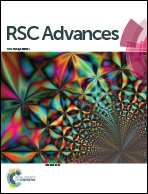A novel ratiometric AIEE/ESIPT probe for palladium species detection with ultra-sensitivity†
Abstract
Existing fluorescent probes for palladium (Pd) species detection have revealed their vulnerabilities, such as low sensitivity, poor anti-interference ability and long reaction time. In order to develop a faster and more accurate detection method for palladium species at extremely low concentrations, in this study, we designed a novel ratiometric AIEE/ESIPT probe (HPNI-1) based on the Tsuji–Trost reaction for Pd. According to the data obtained, the probe was able to detect Pd species with an ultra-high anti-interference ability (Pd : other metals = 1 : 1000), rapid detection time (within 2 minute) and ratiometric fluorescent signal changes with a 1.34 nM detection limit. This study not only proves that existing methods can be improved but also provides future prospects for HPNI-1 as one of the greatest probes for Pd species detection.



 Please wait while we load your content...
Please wait while we load your content...